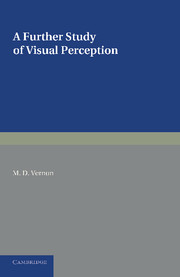Book contents
- Frontmatter
- Contents
- List of Illustrations
- Acknowledgements
- Chapter I INTRODUCTION
- Chapter II THE NATURE OF PERCEPTION
- Chapter III THE PERCEPTUAL PROCESS
- Chapter IV THE DETERMINATION OF FORM
- Chapter V SPATIAL PERCEPTION
- Chapter VI THE CONSTANCIES
- Chapter VII THE FUNCTIONS OF THE FRAMEWORK IN PSYCHO-PHYSICAL EXPERIMENTS
- Chapter VIII THE PERCEPTION OF MOVEMENT
- Chapter IX MICHOTTE'S STUDIES OF SOME INTRINSIC PHENOMENA OF EXPERIENCE
- Chapter X THE INFLUENCE OF INTERNAL AND INDIVIDUAL FACTORS UPON PERCEPTION
- Chapter XI CONCLUSION
- Appendix A
- Appendix B
- References
- Index of Authors
- Index of Subjects
Chapter VIII - THE PERCEPTION OF MOVEMENT
Published online by Cambridge University Press: 05 June 2016
- Frontmatter
- Contents
- List of Illustrations
- Acknowledgements
- Chapter I INTRODUCTION
- Chapter II THE NATURE OF PERCEPTION
- Chapter III THE PERCEPTUAL PROCESS
- Chapter IV THE DETERMINATION OF FORM
- Chapter V SPATIAL PERCEPTION
- Chapter VI THE CONSTANCIES
- Chapter VII THE FUNCTIONS OF THE FRAMEWORK IN PSYCHO-PHYSICAL EXPERIMENTS
- Chapter VIII THE PERCEPTION OF MOVEMENT
- Chapter IX MICHOTTE'S STUDIES OF SOME INTRINSIC PHENOMENA OF EXPERIENCE
- Chapter X THE INFLUENCE OF INTERNAL AND INDIVIDUAL FACTORS UPON PERCEPTION
- Chapter XI CONCLUSION
- Appendix A
- Appendix B
- References
- Index of Authors
- Index of Subjects
Summary
REAL MOVEMENT
We have already noted that we usually assume that objects around us remain stationary unless we perceive them to move in some familiar and recognizable way. Change of position does of course occur without any actual perception of movement being possible; but usually this is associated with certain characteristic and well-known phenomena such as the growth of plants, the rise and fall of tides, the movement of the hands of the clock, and so on. We shall see that in some respects the perception of change of position obeys the same laws as those which govern perception of movement. Nevertheless, it also appears that movement is a phenomenon sui generis. Its perception is schematized and reacted to in certain characteristic ways which have no doubt developed with experience, yet nevertheless seem to be to some extent spontaneous and innate. The characteristic movements of objects are organized within and related to the general spatial framework in somewhat the same way as are the relative distances and separation of stationary objects. We have already pointed out, in Chapter v, that, whenever there is any movement in the field, whichever part of the visual field is taken as framework tends to appear stationary, while that part which is taken to be ‘figural’ appears to move. The schemata into which we organize our visual experiences tend then to allow for smallish objects moving across a steady background—and such of course is our usual experience of events in the surrounding world.
There seems to be some evidence to show that both phylo-genetically and ontogenetically the perception of movement may develop very early as a process distinct from the perception of stationary forms. Gesell et al. (1949) observed that even the prematurely born ‘foetal’ infant showed some awareness of moving objects. Thus movement was linked in primacy with bright light. An infant of four weeks could follow the movements of a dangling ring fairly closely with his eyes through an angle of 90 degrees. In the second quarter of the first year the eye movements had become smooth, accurate, and prolonged through 180 degrees. At about thirty-six weeks he showed considerable interest in movement as such, and appeared to compare the different types of movement he perceived.
- Type
- Chapter
- Information
- A Further Study of Visual Perception , pp. 162 - 182Publisher: Cambridge University PressPrint publication year: 2013



